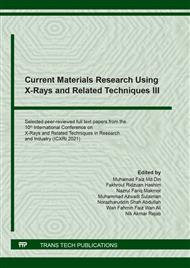[1]
Medina Jaramillo C, González Seligra P, Goyanes S, Bernal C, Famá L, Biofilms based on cassava starch containing extract ofyerba mateas antioxidant and plasticizer, Starch - Stärke, 67(9-10), (2015), 780-789.
DOI: 10.1002/star.201500033
Google Scholar
[2]
Azahari NA, Othman N, Ismail H, Bidodegradable Studies of PVA - Corn Starch, Journal of Physical Science, 22(2), (2011), 15-31.
Google Scholar
[3]
Chattopadhyay H, De AK, Datta S, Novel Starch-PVA Polymer for Microparticle Preparation and Optimization Using Factorial Design Study, International scholarly research notices, 2015, (2015), 261476.
DOI: 10.1155/2015/261476
Google Scholar
[4]
Vroman I, Tighzert L, Biodegradable Polymers, Materials, 2(2), (2009), 307-344.
Google Scholar
[5]
Friedman M, Henika PR, Mandrell RE, Bactericidal Activities of Plant Essential Oils and Some of Their Isolated Constituents against Campylobacter jejuni, Escherichia coli, Listeria monocytogenes, and Salmonella enterica Journal of Food Protection, 65, (2002), 1545–1560.
DOI: 10.4315/0362-028x-65.10.1545
Google Scholar
[6]
Singh G, Maurya S, DeLampasona MP, Catalan CA, A comparison of chemical, antioxidant and antimicrobial studies of cinnamon leaf and bark volatile oils, oleoresins and their constituents, Food Chem Toxicol, 45(9), (2007), 1650-1661.
DOI: 10.1016/j.fct.2007.02.031
Google Scholar
[7]
Balaguer MP, Lopez-Carballo G, Catala R, Gavara R, Hernandez-Munoz P, Antifungal properties of gliadin films incorporating cinnamaldehyde and application in active food packaging of bread and cheese spread foodstuffs, International journal of food microbiology, 166(3), (2013), 369-377.
DOI: 10.1016/j.ijfoodmicro.2013.08.012
Google Scholar
[8]
Mayachiew P, Devahastin S, Effects of drying methods and conditions on release characteristics of edible chitosan films enriched with Indian gooseberry extract, Food Chemistry, 118(3), (2010), 594-601.
DOI: 10.1016/j.foodchem.2009.05.027
Google Scholar
[9]
Lopez P, Sanchez C, Battle R, Nerin C, Vapor-Phase Activities of Cinnamon, Thyme, and Oregano, Journal of Agricultural and Food Chemistry, 55, (2007), 4348−4356.
DOI: 10.1021/jf063295u
Google Scholar
[10]
de Souza AC, Dias AM, Sousa HC, Tadini CC, Impregnation of cinnamaldehyde into cassava starch biocomposite films using supercritical fluid technology for the development of food active packaging, Carbohydr Polym, 102, (2014), 830-837.
DOI: 10.1016/j.carbpol.2013.10.082
Google Scholar
[11]
Ghazali Z, Mohamad SF, Shukri NA, Othman NAF, Sharif J, Application Of Radiation Technology In The Development Of Advanced Packaging Materials For Food Products, Application of Radiation Technology in Development of Advanced Packaging Materials for Food Products, 64.
Google Scholar
[12]
Sun M, Wu Q, Xu J, He F, Brown AP, Ye Y, Vapor-based grafting of crosslinked poly(N-vinyl pyrrolidone) coatings with tuned hydrophilicity and anti-biofouling properties, Journal of Materials Chemistry B, 4(15), (2016), 2669-2678.
DOI: 10.1039/c6tb00076b
Google Scholar
[13]
Sripathi VGP, Mojet BL, Nijmeijer A, Benes NE, Vapor phase versus liquid phase grafting of meso-porous alumina, Microporous and Mesoporous Materials, 172, (2013), 1-6.
DOI: 10.1016/j.micromeso.2013.01.013
Google Scholar
[14]
Hilmi FF, Wahit MU, Shukri NA, Ghazali Z, Zanuri AZ, Physico-chemical properties of biodegradable films of polyvinyl alcohol/sago starch for food packaging, Materials Today: Proceedings, 16, (2019), 1819-1824.
DOI: 10.1016/j.matpr.2019.06.056
Google Scholar
[15]
Nasef MM, Shamsaei E, Ghassemi P, Aly AA, Yahaya AH, Optimization strategies for radiation induced grafting of 4-vinylpyridine onto poly (ethylene-co-tetraflouroethene) film using Box–Behnken design, Radiation Physics and Chemistry, 81(4), (2012), 437-444.
DOI: 10.1016/j.radphyschem.2011.12.019
Google Scholar
[16]
Shukri NA, Ghazali Z, Fatimah NA, Mohamad SF, Wahit MU, Physical, mechanical and oxygen barrier properties of antimicrobial active packaging based on ldpe film incorporated with sorbic acid, Advances in Environmental Biology, (2014), 2748-2753.
Google Scholar


